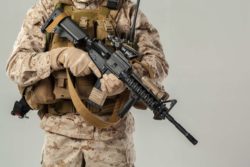Top Class Actions’s website and social media posts use affiliate links. If you make a purchase using such links, we may receive a commission, but it will not result in any additional charges to you. Please review our Affiliate Link Disclosure for more information.
An improvised explosive device (IED) is, as the name implies, improvised. The explosives in an IED attack may be built out of on-hand military materials or whatever else is useful and at one’s disposal. There is no one method of how to make an IED because these explosives vary greatly from place to place.
Unfortunately, IEDs can be relatively simple to make. Learning how to make one is easy — it takes just a small amount of research to learn how to make an IED. This means that both domestic and foreign terrorists can easily build explosive devices to maim and kill innocent people. Recognizing the potential components of an IED may help prevent these materials from being used in a malicious manner.
Components of an IED
Although the methods to make an IED vary, most of the homemade explosives have the same components: a switch (activator), an initiator (fuse), a container (body), a charge (explosive), and a power source (battery). Each IED’s components, however, may vary depending on what is available to the person building it.
According to the Department of Homeland Security, there are a variety of common charges, or explosives, used in IEDs and the components may include commonly used chemicals or specialized explosives such as ammonium nitrate and fuel oil (ANFO), triacetone triperoxide (TATP), Semtex (C-4), ethylene glycol dinitrate (EGON), urea nitrate, and smokeless powder.
ANFO is commonly used in mining and blasting. Although TATP isn’t commonly used, it can be mixed from a combination of common materials. C-4 is a military explosive that may be used if accessible. Similarly, EGDN is a component of low freezing dynamite which can serve as an explosive. Urea nitrate is a common fertilizer but can be repurposed for insidious purposes. Although smokeless powder from ammunition is a low explosive, it can still cause significant damage.
In some cases, IEDs may include “enhancements” such as nails, glass, or fragments of metal which create damaging shrapnel in an explosion. Enhancements may also include toxic chemicals or substances which can start a fire.
How The Parts Work Together
Regardless of which IED components are used, these explosives generally work in the same way.
First, the power source in the IED directs electricity to the bomb’s trigger or switch. The activated trigger then activates the IED’s detonator. This, in turn, triggers the explosion sequence.
After the detonator explodes, energy is provided to the IED’s main explosive. Although the detonator may cause only a spark, the detonated explosives create a large explosion. If the IED includes enhancements, these will be propelled from the explosion at this time.

Other Types of Weapons
There are several other types of weapons that were used by terrorists in the Iraq and Afghanistan war, including Explosively Formed Penetrators (EFPs), Homemade Explosives (HMs), and Improvised Rocket Assisted Munitions (IRAMs).
According to The New York Times, EFPs were one of the most lethal improvised weapons used in the Iraq war. They were originally made to punch holes in metal pipes in oil wells to get to the rock outside. EFPs form “slugs” when they detonate, says The Times, and these slugs are able to maintain their shape for over 100 yards, allowing them to be hidden far from the road.
The New York Times states that EFP technology was passed from Iran to groups fighting in Iraq through Hezbollah, a Lebanese militia. In fact, EFPs reportedly came in kits for insurgents in Iraq, who packed them with plastic explosives for use.
While EFPs require some manufacturing, insurgents also turned to their own Homemade Explosives. According to The New York Times, Iraq is an agricultural society with access to nitrated fertilizers. These fertilizers, mixed with ground urea and nitric acid become powerful explosives when dried, notes the publication. The New York Times notes that, at one point, fertilizer plants in Iraq produced 500,000 tons each year.
IRAMs, also called RAMs, are rocket propelled bombs. Simple in design, propane tanks are filled with explosives and attached to 107mm rockets. Reportedly, Iraq insurgents were able to detonate these remotely, and injure hundreds of soldiers.
IED Attack Compensation
American law prohibits terrorism and even holds parties accountable if they have been found to support international terrorism financially or otherwise. This includes banks or investors who provided funds for the creation of IEDs in the Iraq and Afghanistan Wars.
Federal law on civil remedies, 18 U.S. Code § 2333, allows Americans, including soldiers, who were injured by an act of international terrorism to recover “threefold the damages” the sustained in addition to the cost of taking legal action.
Injured soldiers and the surviving family members of killed service members have already taken legal action under this statute. For example, the widow of an Army staff sergeant joined over 200 other plaintiffs in a lawsuit against the Islamic Republic of Iran in late 2018. According to the plaintiffs, Iran is guilty for much of the damage of the Iraq and Afghanistan wars because they armed terrorist groups with IEDs and other weapons.
Other lawsuits have been filed by victims who survived IED attacks or by the families of those who did not. According to one man whose son was killed by what he believes was an Iran-funded IED, he has five pending lawsuits regarding Iran’s potential involvement in arming militia groups. Patrick F.’s son was killed at the age of 21 in 2006, when an explosive hit the Humvee he was driving. Since then, his family has been fighting for justice for him and the thousands of other injured or dead veterans.
Although many of the lawsuits regarding Iran IEDs are still pending, or have not succeeded in winning compensation for injured vets, some victims of IED attacks have found their justice in other ways, such as with the death of Suleimani.
In early January 2020, General Qasem Suleimani was killed by a U.S. airstrike. It is believed that Suleimani, one of Iran’s most powerful military leaders, was behind many of the attacks against U.S. troops. According to reports from the Pentagon, it is likely that Suleimani and his troops caused the deaths of hundreds of U.S. service members killed by IEDs and other explosives. Although Suleimani may not have taught militia members how to make an IED himself, it is likely that he gave orders and supplied weapons to combatants to use against U.S. service members.
Although Patrick’s lawsuits regarding his son’s death are still pending, he spoke to the New York Times about his emotions following the death of Suleimani. “He changed our lives forever,” he said. “I do take comfort that the last thing he heard was the sound of a United States missile coming down on his head.”
Some banks have pled guilty in this issue as a part of settlements reached with the federal government. HSBC of UK, BNP Paribas of France, and Germany’s Commerzbank are amongst those banks who reportedly helped fund Iran’s weapon production and IED distribution.
In the anti-terrorism lawsuit, the plaintiffs seek compensation for the injuries and deaths of U.S. service members. Although the federal government has recovered significant compensation from banks and other parties, attorneys believe that thousands of U.S. citizens could also recover compensation. Damages recovered under the Anti-Terrorism Act could help compensate injured parties for medical expenses, pain and suffering, wrongful death, and more.
If you or a loved one was injured or killed by an IED or EFP while fighting in the Iraq or Afghanistan wars, legal recourse is available. Get help now by filling out the form on this page for a FREE case evaluation.
The attorneys who work with Top Class Actions will contact you if you qualify to let you know if an individual lawsuit or anti-terrorist class action lawsuit is best for you. (In general, anti-terrorist lawsuits are filed individually by each plaintiff and are not class actions.) After you fill out the form, the attorneys who work with Top Class Actions will contact you if you qualify to let you know if an individual lawsuit or class action lawsuit is best for you. Hurry — statutes of limitations may apply.
ATTORNEY ADVERTISING
Top Class Actions is a Proud Member of the American Bar Association
LEGAL INFORMATION IS NOT LEGAL ADVICE
Top Class Actions Legal Statement
©2008 – 2024 Top Class Actions® LLC
Various Trademarks held by their respective owners
This website is not intended for viewing or usage by European Union citizens.
Get Help – It’s Free
Join a Free Iranian IED, EFP Lawsuit Investigation
If you qualify, an attorney will contact you to discuss the details of your potential case at no charge to you.
PLEASE NOTE: If you want to participate in this investigation, it is imperative that you reply to the law firm if they call or email you. Failing to do so may result in you not getting signed up as a client or getting you dropped as a client.
Email any problems with this form to questions@topclassactions.com.
Oops! We could not locate your form.













